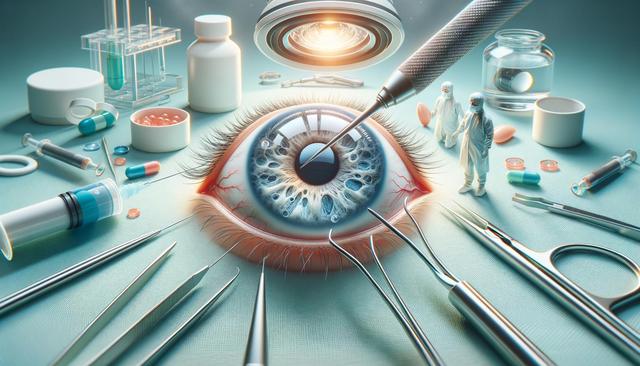Understanding Cataracts and Their Impact on Vision
Cataracts are a common age-related condition that affects the clarity of the eye’s natural lens, leading to symptoms such as blurry vision, sensitivity to light, and difficulty seeing at night. As the population ages, more people are considering cataract procedures as a practical solution to restore their sight and improve their quality of life. Cataracts can develop slowly, making it essential for individuals to monitor their vision and consult with an eye care specialist when early symptoms appear. Although surgery is a widely accepted treatment, there are also Non-Surgical Treatments For Early Cataracts available that can help manage symptoms in the initial stages.
Common signs of cataracts include:
- Cloudy or blurred vision
- Difficulty reading or driving, especially at night
- Increased sensitivity to glare
- Fading or yellowing of colors
Early detection and regular eye exams can help determine the right time for treatment. While non-surgical methods such as special eyewear or brighter lighting can provide temporary relief, they are not long-term solutions once the cataract progresses.
What to Expect from Cataract Surgery
Cataract surgery is one of the most commonly performed and well-regarded procedures in ophthalmology. It involves removing the clouded natural lens and replacing it with a clear, artificial lens. This procedure is typically done on an outpatient basis and is known for its high success rate and minimal recovery time. With advancements in technology, patients now have access to Premium Lens Options For Cataract Surgery, which can significantly enhance post-operative vision.
There are various types of intraocular lenses (IOLs) to choose from, depending on the patient’s lifestyle and visual needs:
- Monofocal lenses – provide clear vision at one distance
- Multifocal lenses – allow for near and far focus
- Toric lenses – correct astigmatism
- Extended depth of focus lenses – offer a continuous range of vision
Discussing these options with a qualified eye surgeon can help patients make informed decisions that align with their daily routines and visual expectations.
Growing Interest in Cataract Procedures
More people are considering cataract procedures not only because of the prevalence of the condition but also due to improvements in surgical techniques and outcomes. The prospect of regaining clarity in vision encourages many individuals to explore their options earlier than in the past. In many regions, clinics are working to provide Affordable Cataract Surgery {city} to make this essential procedure more accessible to a broader population.
Factors contributing to increased interest include:
- Rising awareness of treatment benefits
- Availability of advanced lens technologies
- Shorter recovery periods
- Improved affordability and insurance coverage
With more choices available, patients are better equipped to tailor their cataract treatment plans to their needs, whether through surgical intervention or Non-Surgical Treatments For Early Cataracts when appropriate.
Evaluating Surgical Versus Non-Surgical Options
Choosing between surgery and non-surgical management depends on the stage of the cataract and how much it impacts daily activities. In the early stages, lifestyle adaptations and visual aids might be sufficient. However, as vision deteriorates, surgery becomes the most effective solution to restore eyesight. It’s important for patients to evaluate their options carefully and consult with professionals who can guide them through the decision-making process.
Non-surgical approaches may include:
- Anti-glare sunglasses
- Magnifying lenses for reading
- Updated prescription glasses
- Improved lighting in the home or workplace
Despite these alternatives, surgery is often the definitive treatment. Patients should also consider the benefits of Premium Lens Options For Cataract Surgery to maximize their visual outcomes post-surgery. Discussing the availability of Affordable Cataract Surgery {city} with healthcare providers can help eliminate financial barriers to care.
Preparing for Cataract Surgery and Recovery
Preparation for cataract surgery typically involves several steps, including detailed eye exams, choosing the right lens, and understanding the recovery process. Patients are usually advised to stop certain medications before surgery and arrange for transportation on the day of the procedure. The recovery period is generally quick, with most individuals resuming normal activities within a few days.
Post-surgery care includes:
- Using prescribed eye drops to prevent infection and inflammation
- Avoiding heavy lifting and strenuous activity for a short period
- Wearing protective eyewear as recommended
- Attending follow-up appointments to monitor healing
The success of the surgery largely depends on following post-operative instructions and attending all scheduled check-ups. For those concerned about costs, exploring Affordable Cataract Surgery {city} options and discussing insurance coverage can help ensure access to this vision-restoring procedure.
Conclusion: Making an Informed Choice About Cataract Care
Cataracts are a manageable condition, and with today’s medical advancements, patients have a variety of treatment paths to consider. Whether exploring Non-Surgical Treatments For Early Cataracts or planning for a procedure with Premium Lens Options For Cataract Surgery, individuals are empowered to make choices that suit their vision needs and lifestyle. The growing availability of Affordable Cataract Surgery {city} also makes it possible for more people to access effective care. Consulting with a trusted eye care professional is the first step toward clearer vision and improved quality of life.




Leave a Reply